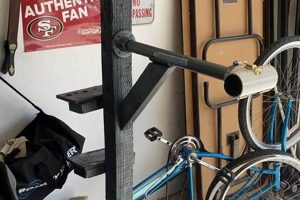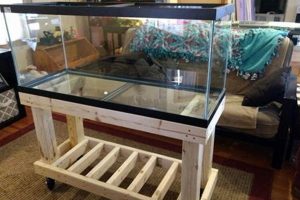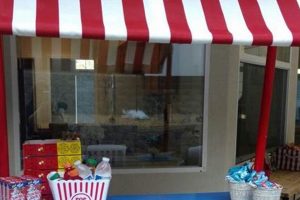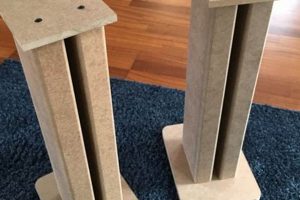Constructing a support structure for audio playback devices, utilizing readily available materials and personal craftsmanship, allows for tailored acoustic positioning. Such a project often involves designing and building a platform to elevate loudspeakers, optimizing sound projection and minimizing unwanted vibrations. As an illustration, one might use wood, metal, or even repurposed materials to fashion a stable base for bookshelf speakers, ensuring optimal sound quality within a listening environment.
The creation of custom-built supports offers several advantages, including cost savings compared to commercially available options and the opportunity to match aesthetic preferences. Historically, individuals have sought methods to isolate loudspeakers from flooring surfaces to reduce resonance and improve clarity. Furthermore, these projects foster creativity and provide a practical application of woodworking, metalworking, or other fabrication skills.
The following sections will explore various design considerations, material choices, and construction techniques relevant to building a customized support system for audio equipment. Topics covered will include stability factors, acoustic damping methods, and step-by-step instructions for different building approaches.
Essential Considerations for Audio Equipment Supports
Optimizing the performance of audio equipment necessitates careful attention to the support structures upon which they rest. The following tips address key aspects of design and construction to ensure both functionality and acoustic enhancement.
Tip 1: Stability is Paramount: Ensure the base is sufficiently weighted and wide to prevent tipping, particularly with larger loudspeakers. Implement a design that evenly distributes the weight of the speaker across the entire structure.
Tip 2: Material Selection Impacts Resonance: The choice of materials, whether wood, metal, or composite, influences the transmission of vibrations. Consider employing materials with inherent damping properties, such as medium-density fiberboard (MDF), or incorporating damping materials into the design.
Tip 3: Height Optimization Improves Soundstage: Determining the appropriate height involves aligning the loudspeaker’s tweeter with the listener’s ear level. Experimentation may be necessary to achieve optimal imaging and soundstage within the listening environment.
Tip 4: Decoupling Reduces Unwanted Vibrations: Implement decoupling techniques, such as the use of rubber feet, spikes, or isolation pads, to minimize the transfer of vibrations from the loudspeaker to the floor or supporting structure.
Tip 5: Cable Management Enhances Aesthetics and Safety: Integrate cable management solutions into the design to conceal wires and prevent tripping hazards. Consider routing cables internally or utilizing external clips and channels.
Tip 6: Consider the Room Acoustics: The room’s acoustic properties will influence the perceived sound. The design of the support structure can be adjusted to complement or mitigate existing acoustic characteristics.
Tip 7: Structural Integrity is Essential: Ensure that all joints are securely fastened and that the overall construction is robust enough to withstand the weight and potential vibrations of the loudspeaker. A structurally sound design is crucial for long-term reliability.
Adhering to these principles will contribute to the creation of a stable, acoustically optimized support system that enhances the listening experience.
The subsequent section will delve into specific building plans and advanced techniques for realizing a customized support system.
1. Stability
The stability of a self-constructed audio equipment support system is paramount to its functional effectiveness and the safety of the equipment it holds. Instability can lead to the tipping or collapse of the structure, resulting in potential damage to the loudspeakers and posing a safety hazard. The cause-and-effect relationship is direct: inadequate stability leads to undesirable outcomes. A properly designed support must possess a sufficient base area and weight distribution to counteract the center of gravity of the supported speaker, minimizing the risk of accidental displacement. For example, a tall, slender stand supporting a heavy bookshelf speaker presents a high risk of tipping if the base is not sufficiently wide or weighted.
The importance of stability in a self-built audio equipment support cannot be overstated. A stable structure ensures that the speaker operates under optimal conditions, free from vibrations caused by its own movement. This contributes to a clearer and more accurate sound reproduction. Furthermore, stability enhances the longevity of the equipment by preventing accidental falls and subsequent damage. A practical example involves constructing a base from heavy materials such as concrete or steel, significantly increasing the overall stability of the speaker support. Another approach is to widen the base of the structure, lowering the center of gravity and improving resistance to tipping forces. The practical significance of understanding this principle is reflected in the reduced likelihood of equipment damage and the enhanced listening experience.
In summary, stability forms a crucial foundation for any successfully designed and implemented audio equipment support system. Overlooking this aspect introduces potential hazards and compromises the intended acoustic performance. While design choices must consider aesthetics and cost, the stability of the structure must be the primary concern to ensure safe and effective operation. This requirement presents a challenge to the designer, balancing creative vision with sound engineering principles to achieve a robust and reliable final product.
2. Material Resonance
Material resonance, an inherent property of all physical substances, significantly influences the performance characteristics of an audio equipment support structure. When a loudspeaker generates sound, its vibrations can transmit through the support, potentially causing the materials used in its construction to resonate. This sympathetic vibration introduces unwanted coloration to the sound, blurring clarity and distorting the intended sonic profile. The cause-and-effect relationship is clear: materials with high resonance potential amplify extraneous vibrations, leading to decreased audio fidelity. Therefore, careful material selection is paramount in the creation of any audio support, influencing its capacity to deliver accurate sound reproduction. An example includes constructing a speaker stand from a highly resonant material like thin steel. This would likely result in a ringing sound, as the steel vibrates in response to the speakers output, obscuring the nuances of the audio signal. In contrast, utilizing a dense, non-resonant material such as MDF (Medium-Density Fiberboard) or a constrained-layer damping composite would minimize these unwanted vibrations, allowing the speaker to perform more accurately.
The importance of material resonance extends beyond mere acoustic accuracy; it also affects the perceived soundstage and overall listening experience. By minimizing the resonant frequencies of the support structure, one can achieve a cleaner, more focused soundstage, where individual instruments and vocals are more clearly defined. Several practical applications exist for mitigating material resonance in audio equipment supports. These include the strategic application of damping materials, such as rubber or viscoelastic polymers, to absorb and dissipate vibrational energy. Another approach involves constructing the support from multiple layers of different materials, creating a constrained-layer damping effect that reduces resonance more effectively than a single material alone. For example, layering a thin sheet of aluminum between two layers of MDF and bonding them together with a vibration-damping adhesive can create a highly effective, non-resonant platform for a loudspeaker.
In conclusion, material resonance represents a critical design factor in the construction of an audio equipment support. Careful consideration of the resonant properties of various materials, combined with the application of appropriate damping techniques, can significantly improve the acoustic performance of a sound system. While challenges may arise in balancing material costs and design complexity, the effort invested in mitigating material resonance ultimately translates into a superior listening experience. The understanding of these principles provides a foundation for creating supports that enhance, rather than detract from, the overall audio quality.
3. Optimal Height
The determination of the optimal height for an audio loudspeaker, particularly when constructing a support structure, directly influences the perceived sound quality and accuracy. When the radiating elements of a loudspeaker, specifically the tweeter, are not positioned at the appropriate vertical orientation relative to the listener, the frequency response may be skewed, leading to inaccuracies in the perceived soundstage and tonal balance. The cause-and-effect relationship is evident: incorrect height placement results in a compromised listening experience. For instance, if the tweeter is positioned significantly below the listener’s ear level, high-frequency information may be attenuated, leading to a dull or muffled sound. Conversely, a tweeter positioned too high may result in an overly bright or harsh sound, lacking warmth and depth. Therefore, in the context of a customized support construction, ensuring the appropriate vertical alignment is critical for achieving optimal acoustic performance. This factor is particularly important when an individual is aiming to implement a diy speaker stand, as the height is not restricted to pre-set parameters.
The practical significance of understanding and achieving optimal loudspeaker height lies in its ability to enhance the listener’s immersion and enjoyment of audio content. By positioning the speakers correctly, the listener is able to experience a more accurate and natural sound reproduction, with a greater sense of spaciousness and realism. This is especially crucial for critical listening applications, such as audio mixing and mastering, where accurate sound reproduction is essential for making informed decisions. The practical applications of this understanding are manifold. One approach is to measure the listener’s seated ear height and design the speaker support to achieve this specific tweeter height. Another approach is to use adjustable-height supports, allowing for fine-tuning of the speaker’s vertical position to accommodate different listening environments and preferences. Consider a scenario where an individual constructs a support that places the tweeter 6 inches below ear-level. The effect may be an experience that lacks clarity in the high-frequencies of the listening environment.
In summary, the concept of optimal height is a fundamental consideration in speaker support design. While factors such as aesthetics and cost may influence the overall design, the acoustic benefits of correct vertical speaker placement are undeniable. While achieving this optimal height requires careful planning and execution, the resulting improvement in sound quality makes the effort worthwhile. Recognizing the link between speaker height and the subjective listening experience empowers those engaging in speaker support construction to make informed decisions that prioritize acoustic performance and listener satisfaction, ultimately leading to a superior auditory experience.
4. Vibration Decoupling
In the context of audio equipment support, vibration decoupling refers to a range of techniques employed to minimize the transfer of vibrational energy from the loudspeaker to its supporting structure and vice versa. This is particularly relevant in the design and construction of a diy speaker stand, where the choice of materials and construction methods can significantly impact the degree of vibrational coupling within the system.
- Material Selection and Damping Properties
The material composition of a diy speaker stand directly influences its ability to transmit or dampen vibrations. Dense, rigid materials like concrete or metal can effectively transmit vibrations, while softer materials like rubber or cork tend to absorb them. Incorporating materials with inherent damping properties, or applying damping compounds to the stand’s structure, can significantly reduce vibrational transfer and minimize unwanted resonance. For instance, a stand constructed from hollow steel tubes might benefit from filling the tubes with sand or using constrained layer damping techniques.
- Isolation Techniques: Spikes, Pads, and Platforms
Physical isolation is a key aspect of vibration decoupling. This often involves employing devices that minimize the contact area between the loudspeaker and the stand, or between the stand and the floor. Spikes, for example, provide a small contact point that reduces the transmission of vibrations into the floor. Conversely, soft pads or platforms made from materials like neoprene or sorbothane can absorb vibrations before they reach the stand. In the context of a diy speaker stand, such decoupling elements can be integrated into the design, enhancing the isolation between the speaker, stand, and listening environment.
- Structural Design and Resonance Control
The design of a diy speaker stand itself can influence vibration decoupling. A well-braced, rigid structure is less prone to resonating than a flimsy one. The use of non-parallel surfaces and internal damping can further reduce resonances within the stand’s structure. For example, a stand with angled legs or internal bracing will exhibit reduced resonance compared to a simple, box-shaped design. The goal is to create a support that is inherently resistant to vibration, minimizing its impact on the loudspeaker’s performance.
- Impact on Sound Quality and Clarity
Effective vibration decoupling contributes directly to improved sound quality and clarity. By minimizing the transmission of vibrations, the listener perceives a cleaner, more focused soundstage with reduced coloration and distortion. This allows for a more accurate and detailed reproduction of the audio signal. A diy speaker stand that effectively decouples the speaker from its surroundings will result in a more transparent and accurate listening experience, allowing the listener to appreciate the nuances of the audio content without unwanted interference.
Implementing vibration decoupling techniques in a diy speaker stand project involves careful consideration of material selection, design principles, and isolation methods. By prioritizing these aspects, the resulting support structure can significantly enhance the listening experience, delivering improved sound quality and clarity for the audio enthusiast. The principles of vibration decoupling extend beyond mere construction, entering the realm of acoustic optimization and critical listening.
5. Cable Management
The integration of cable management solutions into a self-constructed loudspeaker support system addresses both aesthetic and functional considerations. Exposed cables present potential tripping hazards and detract from the visual appeal of a listening environment. Furthermore, improperly managed cables can be susceptible to damage and can introduce unwanted electrical interference into the audio signal. The construction of a diy speaker stand, therefore, necessitates careful planning for cable routing and concealment.
The incorporation of cable management features is a practical necessity in a homemade speaker support system. This may involve drilling channels within the structure to accommodate cables, integrating cable clips or ties to secure wires along the stand’s frame, or designing a base that provides a concealed space for excess cable length. For instance, a diy speaker stand crafted from wood could incorporate a vertical channel along its rear face, allowing speaker cables to be discreetly routed from the speaker to the amplifier. Alternatively, a metal stand could feature welded cable clips along its support legs. Effective cable management not only enhances the visual presentation of the system but also contributes to improved signal integrity and safety.
In summary, cable management constitutes an integral aspect of a well-designed diy speaker stand. While the primary function of the support is to provide a stable and acoustically optimized platform for the loudspeaker, the implementation of effective cable management elevates the overall quality and usability of the system. The challenge lies in seamlessly integrating these features into the design, without compromising the structural integrity or aesthetic appeal of the support structure. This integration ultimately leads to a more refined and functional audio setup.
6. Structural Integrity
Structural integrity, the ability of a load-bearing structure to withstand applied stresses without failure, is of critical importance in the context of a “diy speaker stand”. A compromised structure can lead to instability, equipment damage, and potential safety hazards. Therefore, careful consideration must be given to the design and construction of a speaker stand to ensure it possesses adequate structural integrity for its intended purpose.
- Material Selection and Load Capacity
The choice of materials directly dictates the load-bearing capacity of the stand. Materials such as solid hardwoods, steel, or thick-gauge aluminum offer superior strength compared to less robust options like particleboard or thin-walled plastics. The selected material must be capable of supporting the weight of the loudspeaker with a significant margin of safety. For example, a stand constructed from pine might be suitable for small, lightweight speakers, while a heavier speaker would necessitate a stronger material like oak or steel.
- Joint Strength and Construction Techniques
The manner in which individual components are joined together significantly influences the overall structural integrity. Weakly constructed joints can become points of failure under stress. Strong and durable joints can be achieved through the use of appropriate fasteners (screws, bolts, adhesives), robust joinery techniques (mortise and tenon, dovetails), and proper assembly procedures. As an example, a stand assembled with only glue may be adequate for light loads but would likely fail under the weight of a larger speaker, whereas a stand using screws and glue or traditional woodworking joints would be far more stable.
- Stability and Base Design
The overall stability of the stand is inextricably linked to its structural integrity. A wide, well-supported base provides resistance to tipping forces and helps distribute the weight of the speaker evenly. Conversely, a narrow or unstable base can compromise the stand’s ability to support the speaker safely. The inclusion of features like weighted bases or adjustable feet can further enhance stability. For instance, a stand with a small footprint could be made more stable by adding a weighted base or extending the footprint through the addition of outriggers.
- Dynamic Loading and Resonance Considerations
Beyond static weight, the stand must also withstand dynamic forces generated by the speaker itself. Vibrations and sound pressure waves can induce stresses within the structure, potentially leading to fatigue and eventual failure. Damping materials and rigid construction techniques can help mitigate these dynamic loads. A diy speaker stand created with an inadequate design may suffer from resonances, leading to structural weakness and a decline in audio quality, while incorporating elements that address those challenges would ensure greater resistance to vibration-induced stresses.
These facets collectively highlight the critical importance of structural integrity in the design and construction of a “diy speaker stand”. By carefully considering material selection, joint strength, base design, and dynamic loading, it is possible to create a support structure that is both safe and acoustically effective. The construction of a diy speaker stand should not only adhere to aesthetic and cost considerations, but also ensure sufficient structural capacity to accommodate the loads, while simultaneously controlling the impact of speaker resonance. Neglecting structural integrity can result in compromised speaker performance, damaged equipment, and potential hazards.
Frequently Asked Questions
The following addresses common inquiries regarding the design, construction, and implementation of self-made loudspeaker support systems.
Question 1: What are the primary advantages of constructing a speaker support system rather than purchasing a commercially available product?
Building a support structure allows for customization to specific dimensions and aesthetic preferences, often at a lower cost compared to prefabricated options. Furthermore, it provides an opportunity to utilize specific materials tailored to the acoustic properties of the listening environment.
Question 2: What materials are most suitable for constructing a speaker support to minimize unwanted resonance?
Dense, non-resonant materials such as medium-density fiberboard (MDF), hardwoods, or constrained-layer damping composites are preferred. These materials effectively dampen vibrations and reduce coloration of the audio signal.
Question 3: How does the height of the speaker relative to the listener affect the perceived sound quality?
Optimal speaker height aligns the tweeter with the listener’s ear level. This alignment ensures accurate frequency response and optimal soundstage imaging. Deviations from this height can result in attenuated high frequencies or an unbalanced tonal presentation.
Question 4: What techniques can be employed to effectively decouple the speaker from the support structure?
Decoupling can be achieved through the use of isolation pads, rubber feet, or spikes. These elements minimize the transfer of vibrations between the speaker and the support, reducing unwanted resonance and improving sound clarity.
Question 5: How can cable management be integrated into a DIY speaker support design?
Cable management solutions include internal channels, external clips, or a concealed base compartment. These features allow for discreet routing of cables, enhancing aesthetics and preventing tripping hazards.
Question 6: What safety considerations should be prioritized during the construction of a speaker stand?
Stability is paramount. Ensure the base is sufficiently weighted and wide to prevent tipping. Use appropriate fasteners and construction techniques to create a structurally sound and durable support capable of safely supporting the weight of the speaker.
In summary, constructing a speaker support structure offers unique benefits in terms of customization and cost-effectiveness. Understanding material properties, height optimization, vibration decoupling, cable management, and safety considerations is crucial for achieving optimal results.
The next section will explore advanced design techniques for enhanced acoustic performance.
Conclusion
This exposition has detailed the multifaceted considerations involved in the creation of a diy speaker stand. From structural integrity and material resonance to optimal height and vibration decoupling, the successful construction of such a support system demands a thorough understanding of acoustic principles and engineering practices. Adherence to these guidelines is essential for realizing the full potential of audio equipment and maximizing the listening experience.
The pursuit of an acoustically optimized environment through a diy speaker stand is an ongoing endeavor. It requires continuous experimentation and refinement to achieve optimal performance. The knowledge and techniques presented herein serve as a foundation for future exploration and innovation in the field of audio equipment support systems. Careful application of these principles will yield demonstrably superior sonic outcomes.







